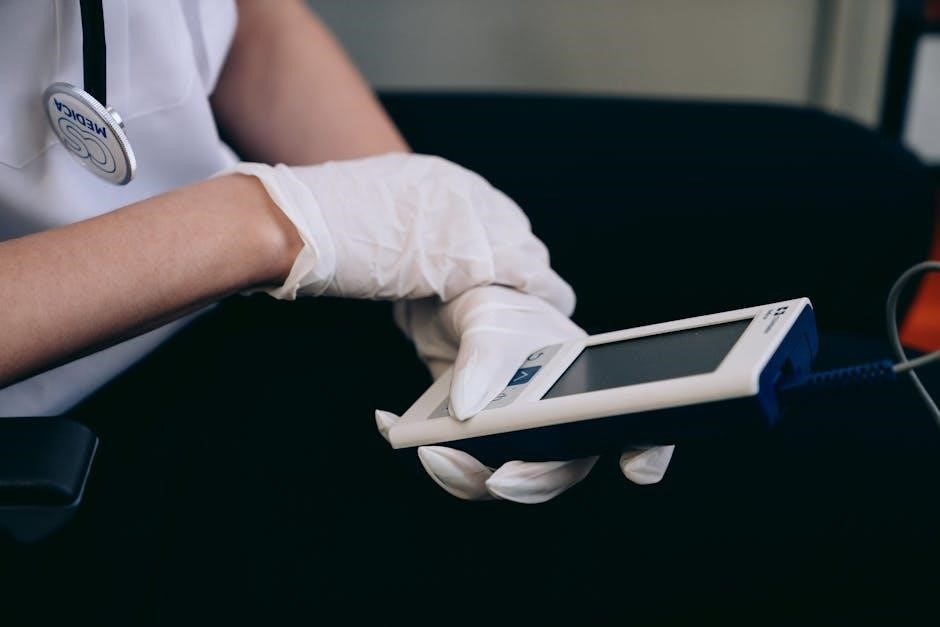A nursing care plan is a structured document outlining patient-specific health interventions, goals, and outcomes. It guides evidence-based care, ensuring personalized and effective patient management.
Definition and Purpose of Nursing Care Plans
A nursing care plan is a structured document created by healthcare professionals to outline personalized interventions for patients. It defines specific health goals, interventions, and outcomes based on patient needs. The purpose is to ensure evidence-based, patient-centered care by addressing diagnoses, promoting comfort, and preventing complications. Care plans guide nurses in delivering consistent, high-quality care and serve as a communication tool for healthcare teams. They are tailored to individual patient conditions, ensuring interventions are effective and measurable. The plan includes priorities, client goals, and rationales, often informed by nursing theories like the Needs Theory. Regular assessments and updates ensure the plan adapts to changing patient needs, fostering optimal health outcomes and continuity of care.
Importance of Nursing Care Plans in Patient Care
Nursing care plans are essential for delivering individualized, evidence-based patient care. They ensure consistency and clarity in interventions, promoting better health outcomes and patient satisfaction. By outlining specific goals and interventions, care plans help nurses prioritize actions, reducing the risk of omissions in care. They also serve as a communication tool among healthcare teams, ensuring everyone is aligned on the patient’s needs. Care plans adapt to changing patient conditions, addressing acute and chronic needs effectively. For example, plans for COPD or pain management provide structured approaches to symptom relief and disease control. This systematic approach enhances patient outcomes, making nursing care plans a cornerstone of effective patient care delivery.

Components of a Nursing Care Plan
- Nursing Diagnosis: Identifies patient health issues.
- Goals/Outcomes: Define measurable patient objectives.
- Interventions: Outline specific care actions.
- Documentation: Track progress and evaluations.
Nursing Diagnosis and Assessment
Nursing diagnosis involves identifying actual or potential health problems based on patient assessments. This step is crucial for developing targeted care plans. Nurses gather data through observations, interviews, and medical records to determine specific needs. The diagnosis is formulated using standardized terminology, ensuring clarity and consistency. For example, in a patient with COPD, the diagnosis might focus on impaired gas exchange or activity intolerance. Accurate assessment and diagnosis guide interventions, promoting effective patient outcomes. Regular reassessments ensure the care plan adapts to changing patient conditions, maintaining relevance and efficacy throughout the care process.

Setting SMART Goals and Outcomes
Setting SMART (Specific, Measurable, Achievable, Relevant, Time-bound) goals is essential in nursing care plans to ensure clear, actionable objectives. Goals should address identified nursing diagnoses and align with patient priorities. For example, a goal for a patient with COPD might be to “increase walking distance to 100 feet without shortness of breath within two weeks.” Outcomes are the expected results of these goals, providing a framework to evaluate progress. Regularly reviewing and updating goals ensures they remain relevant and patient-centered. This structured approach enhances accountability and improves the likelihood of achieving desired health outcomes, making care more effective and patient-focused.

Nursing Interventions and Rationale
Nursing interventions are specific actions taken to address patient needs and achieve care goals. They are guided by evidence-based practices and tailored to individual patient circumstances. For example, in a COPD care plan, interventions might include oxygen therapy and pulmonary rehabilitation. The rationale explains the scientific or theoretical basis for these actions, ensuring they are logical and effective. Using frameworks like the Needs Theory can strengthen the rationale. Interventions are documented with clear outcomes, allowing nurses to track progress and adjust care as needed. This systematic approach ensures interventions are purposeful and aligned with patient goals, enhancing the quality of care and promoting better health outcomes.
Documentation and Evaluation
Documentation is a critical component of nursing care plans, ensuring continuity and accountability. It involves recording patient assessments, interventions, and responses. Evaluation assesses whether goals are met, identifying progress or needed adjustments. Using standardized formats like SOAP (Subjective, Objective, Assessment, Plan) ensures clarity. Regular reviews allow nurses to update care plans, reflecting changes in patient condition or new data. Effective documentation supports legal compliance and improves communication among healthcare teams. Evaluation also helps in refining future interventions, promoting evidence-based practice and enhancing patient outcomes. Accurate and timely documentation is essential for delivering high-quality, patient-centered care and meeting professional standards. It fosters transparency and accountability in nursing practice.

How to Write a Nursing Care Plan
Writing a nursing care plan involves a structured approach, starting with patient assessment and diagnosis. Next, set SMART goals and outline interventions with clear rationale. Using nursing theories ensures effectiveness.
Step-by-Step Guide to Creating a Care Plan
Creating a care plan involves a systematic approach to ensure comprehensive patient care. Begin with a thorough patient assessment, identifying specific needs and health goals. Next, prioritize nursing diagnoses based on urgency and impact. Develop SMART goals that are measurable and time-bound. Outline interventions, including actions and rationale, tailored to the patient’s condition. Document the plan clearly, using standardized templates for consistency. Implement the interventions and monitor progress regularly. Evaluate outcomes and revise the plan as needed. Continuous communication with the patient and healthcare team ensures alignment with their expectations and promotes optimal results.
Using Nursing Theories and Models
Nursing theories and models provide a framework for developing structured and patient-centered care plans. Theories such as Maslow’s Hierarchy of Needs and the Nursing Process guide nurses in prioritizing care. Models like the Roy Adaptation Model help identify patient adapations to health challenges. These frameworks ensure interventions align with patient needs and promote holistic care. For example, using the Needs Theory, nurses can address physiological and emotional requirements. Incorporating these theories enhances the care plan’s effectiveness and consistency. They also aid in documenting patient responses and evaluating outcomes, ensuring evidence-based practice. Utilizing theories and models not only improves care quality but also supports professional nursing standards and patient-centered outcomes.
Prioritizing Nursing Diagnoses
Prioritizing nursing diagnoses is crucial to address the most critical patient needs first. This ensures effective and timely care. Factors such as the severity of symptoms, patient safety, and immediate risks guide prioritization. For instance, a patient with acute respiratory distress may take precedence over one with chronic pain. Nurses use frameworks like the ABCD method (Airway, Breathing, Circulation, Disability) to assess and rank priorities. Maslow’s Hierarchy of Needs also helps, focusing on physiological needs first. Regular reassessment ensures priorities are updated as patient conditions evolve. This systematic approach maximizes outcomes and ensures resource allocation aligns with patient demands. Effective prioritization is a cornerstone of efficient and compassionate nursing care.

Examples of Nursing Care Plans
Examples of nursing care plans provide structured templates for various patient conditions, such as COPD, pain management, and infection control, guiding personalized care and education effectively.

Care Plan for a Patient with Chronic Obstructive Pulmonary Disease (COPD)
A COPD care plan focuses on managing symptoms, improving respiratory function, and enhancing quality of life. The nursing diagnosis often includes activity intolerance and ineffective breathing patterns. SMART goals are set to increase mobility and reduce shortness of breath. Interventions may involve oxygen therapy, pulmonary rehabilitation, and medication management. Patient education on inhaler use and smoking cessation is crucial. Regular assessments monitor lung sounds, oxygen saturation, and energy levels. Progress is documented, and the care plan is adjusted as needed to address changing symptoms and achieve optimal outcomes. This structured approach ensures comprehensive and personalized care for patients with COPD.

Care Plan for a Patient with Pain Management Needs
A pain management care plan focuses on assessing and alleviating a patient’s pain effectively. Nursing diagnoses often include acute or chronic pain and anxiety related to discomfort. SMART goals aim to reduce pain intensity, improve mobility, and enhance the patient’s quality of life. Interventions may include pharmacological treatments, such as analgesics, and non-pharmacological methods like relaxation techniques or heat therapy. Regular documentation of pain levels using standardized tools, such as the 0-10 pain scale, is essential. Patient education on pain management strategies and medication adherence is prioritized. The care plan is adjusted based on the patient’s response and feedback, ensuring personalized and compassionate care to achieve optimal pain relief and functional outcomes.
Care Plan for a Patient with Infection Control Requirements
A care plan for infection control focuses on preventing the spread of infection and promoting a patient’s recovery. Nursing diagnoses may include risk of infection or impaired immune response. Goals aim to eliminate the infection source, prevent transmission, and enhance the patient’s immune response. Interventions include isolation precautions, proper hand hygiene, and antimicrobial therapy. Documentation involves monitoring infection status and adherence to protocols. Patient education emphasizes infection prevention strategies, such as proper wound care and hygiene practices. Regular evaluation ensures the effectiveness of interventions and adjusts the plan as needed to achieve optimal infection control outcomes and prevent complications.

Tools and Resources for Nursing Care Plans
Nursing care plans are supported by downloadable templates, specialized software, and reference guides. These tools enhance standardization and adherence to best practices in patient care.
Downloadable Nursing Care Plan Templates
Downloadable nursing care plan templates are essential tools for streamlining care planning. They provide structured formats for documenting patient assessments, diagnoses, goals, and interventions. Many templates are available online, offering flexibility for customization based on specific patient needs. These templates often include sections for prioritizing diagnoses, setting SMART goals, and outlining evidence-based interventions. They are particularly useful for students and professionals seeking to improve documentation accuracy and efficiency. Resources like professional nursing associations and educational websites offer free or purchasable templates in PDF and other formats. Utilizing these templates ensures consistency and adherence to best practices in patient care delivery.
Software and Digital Tools for Care Planning
Software and digital tools have revolutionized the creation and management of nursing care plans. These platforms offer customizable templates, real-time collaboration, and data tracking features, enhancing efficiency and organization. Many tools integrate with electronic health records (EHRs), ensuring seamless updates and accessibility. Additionally, some software provides libraries of nursing care plan examples in PDF format, serving as valuable resources for education and reference. These digital solutions not only streamline the care planning process but also support adherence to best practices and regulatory standards, making them indispensable in modern healthcare settings.
References and Guides for Best Practices
References and guides for best practices in nursing care planning are essential for ensuring evidence-based and standardized care. Resources like the Nurses Pocket Guide by Doenges, Moorhouse, and Murr provide prioritized nursing diagnoses, interventions, and rationales. Professional organizations, such as the Association of New Brunswick Licensed Practical Nurses, offer detailed frameworks for creating care plans. These guides emphasize the importance of assessment, goal setting, and documentation. They also highlight the use of nursing theories, such as Maslow’s Hierarchy of Needs, to inform care strategies. By adhering to these references, nurses can deliver high-quality, patient-centered care while maintaining compliance with industry standards and best practices.
Comments